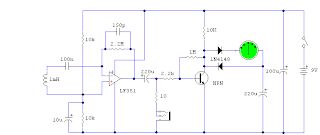One of the most useful gadgets a video enthusiast can have is a low-power TV Transmitter. Such a device can transmit a signal from a VCR to any TV in a home or backyard. Imagine the convenience of being able to sit by the pool watching your favorite movie on a portable with a tape or laserdisc playing indoors. You could even retransmit cable TV for your own private viewing. Videotapes can be dubbed from one VCR to another without a cable connecting the two machines together.
When connected to a video camera, a TV transmitter can be used in surveillance for monitoring a particular location. The main problem a video enthusiast has in obtaining a TV transmitter is that a commercial units are expensive. However, we have some good news! You can build the TV Transmitter described here for less than $30 in one evening! The easiest way to do that is to order the kit that‚s available from the source given in the Parts List (a custom case for the kit is also available). Nevertheless, we present enough information here to build the TV Transmitter from scratch.
The TV Transmitter combines line- level audio and video signals, and transmits the resulting signal up to 300 feet. The circuit can be powered from a 9- volt battery. It is suggested that a 12-volt DC supply during be used during the alignment procedure. This would insure maximum transmission range and best possible picture. Aligning the TV Transmitter requires no special equipment whatsoever, and it is a very simple procedure. The Transmitter's output can be tuned to be received on any TV channel from 2 to 6. The range of channels is wide enough so that the unit will not interfere with other TV viewers who are nearby. To comply with FCC rules, it is mandatory the nearby TV viewers are not disturbed by the transmission. If your activities interfere with the reception from a licensed station, regardless of the reason, you must shut down your unit.
Circuit Description:
Figure 1 is the schematic diagram of the TV Transmitter circuit. Video signals input at jack J1 are first terminated by resistor R6 and coupled through capacitor C1 to clamping-diode D1. The clamping forces the sync pulses to a fixed DC level to reduce blooming effects. Potentiometer R3 is used to set the gain of the video signal; its effect is similar to that of the contrast control on a TV set. Bias-control R7 can be used to adjust the black level of the picture so that some level of signal is transmitted, even for a totally dark picture. That way, a TV receiver can maintain proper sync. As we'll get to later, potentiometers R3 and R7 are cross adjusted for the best all-around performance.
RF-transformer T1 and its internal capacitor form the tank circuit of a Hartley oscillator that's tuned to 4.5 megahertz. Audio signals input at J2 are coupled to the base of Q3 via C2 and R4: the audio signal modulates the base signal of Q3 to form an audio subcarrier that‚s 4.5-megahertz higher than the video-carrier frequency. The FM modulated subcarrier is applied to the modulator section through C5 and R9. Resistor R9 adjusts the level of the subcarrier with respect to the video signal. Transistors Q1 and Q2 amplitude modulate the video and audio signals onto an RF-carrier signal. The operating frequency is set by coil L4, which is 3.5 turns of 24- gauge enameled wire on a form containing a standard ferrite slug.
That coil is part of a Colpitts tank circuit also containing C7 and C9. The tank circuit forms Q4's feedback network, so Q4 oscillates at the set frequency The RF output from the oscillator section is amplified by Q5 and Q6, whose supply voltage comes from the modulator section. Antenna matching and low-pass filtering is performed by C12, C13, and L1. Resistor R12 is optional; it is added to help match the output signal to any kind of antenna. (More on that in a moment.)
PARTS LIST FOR THE
TV TRANSMITTER
SEMICONDUCTORS
D1—1N914 silicon diode
Q1-Q—2N3904 NPN transistor
RESISTORS
(All fixed resistors are 1/4-watt, 5% units .)
R1, R2, R11—1000-ohm
R3, R7—1000-ohm trimmer potentiometer, PC-
mount
R4, R9, R10—10,000-ohm
R5—47,000-ohm
R6—75-ohm
R8—4700-ohm
R12—75-ohm (optional, see text)
CAPACITORS
C1, C8—100-µF, 16-WVDC, electrolytic
C2—2.2--µF, 50-WVDC, electrolytic
C3-C6, C11, C14, C15—001-µF, ceramic-disc
C7, C9—2.2-pF, ceramic-disc
C10—100-pF, ceramic-disc
C12, C13—68-pF, ceramic-disc
ADDITIONAL PARTS AND MATERIALS
ANT1—Antenna, telescopic-whip
B1—9-volt battery
J1-J3—RCA jack, PC-mount
L1—0.15-µH miniature inductor
L2, L3—2.2-µH miniature inductor
L4—0.14- to 0.24-mH adjustable, slug-tuned coil
(see text)
S1—SPST, push-button switch, normally open
T1—4.5-MHz 1F-can-style RF transformer (see
text)
Printed-circuit materials or pre-fab PC board,
battery holder and connector, pair of RCA
patch cords, solder, hardware, etc.
Note: The following items are available from
Ramsey Electronics, Inc.
793 Canning Parkway
Victor, NY 14564
Tel. 716-924-4560
TV-6 TV Transmitter Kit (includes PC board and all
components except R12)—$27.95; kit of all
components (except R12)—$17.95; PC board
only—$10.00; CTV matching-case set—$14.95.
NY State residents please add appropriate sales
tax.
Sourch












































